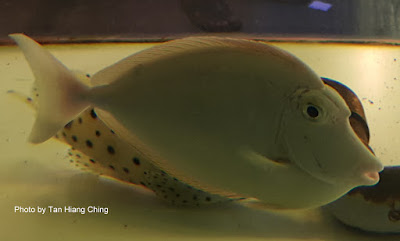Surgeonfishes
Surgeonfishes, tangs, and unicornfishes are members of the Acanthuridae family. They are distributed worldwide mostly in tropical seas. They have a deep compressed body with the eye high on the head and a long preorbital bone. The distinctive characteristic of the family is the sharp caudal spines of the tail, which are dangerously sharp. Their dorsal, anal, and caudal fins are large, extending for most of the length of the body. Their small mouth have a single row of teeth used for algae grazing. Many species have bright colours and are popular aquarium fishes.
Surgeonfishes are marine fishes usually found around coral reefs or over rocky substrate, generally at depths less than 100 m. They sometimes feed as solitary individuals, but they also often travel and feed in schools. Most surgeonfishes species graze on benthic algae and seagrass, while some species mainly feed on zooplankton or detritus. Surgeonfishes are able to slash other fishes with their sharp caudal spines by a rapid side sweep of the tail. They are pelagic spawners.
The family Acanthuridae is divided into 3 subfamilies with different caudal spine characteristic. The Acanthurinae subfamily has a single folding spine on each side of caudal peduncle. The Prionurinae subfamily has 3 to 10 fixed bony peduncular plates, becoming keeled with age. And finally the Nasinae has 1 or 2 fixed peduncular plates, also keeled with age. There are 6 genera and 85 species worldwide. Malaysia has 5 genera and about 33 species.
Surgeonfishes are marine fishes usually found around coral reefs or over rocky substrate, generally at depths less than 100 m. They sometimes feed as solitary individuals, but they also often travel and feed in schools. Most surgeonfishes species graze on benthic algae and seagrass, while some species mainly feed on zooplankton or detritus. Surgeonfishes are able to slash other fishes with their sharp caudal spines by a rapid side sweep of the tail. They are pelagic spawners.
The family Acanthuridae is divided into 3 subfamilies with different caudal spine characteristic. The Acanthurinae subfamily has a single folding spine on each side of caudal peduncle. The Prionurinae subfamily has 3 to 10 fixed bony peduncular plates, becoming keeled with age. And finally the Nasinae has 1 or 2 fixed peduncular plates, also keeled with age. There are 6 genera and 85 species worldwide. Malaysia has 5 genera and about 33 species.
Scientific Name: Acanthurus mata (Cuvier, 1829)
English Name: Elongate Surgeonfish, Bleeker's Surgeonfish, Blue-lined Surgeonfish, Pale Surgeonfish
Chinese Name | 鱼类中文名: 后刺尾鲷 (Hòu cì wěi diāo), 暗色刺尾鱼 (Àn sè cì wěi yú), 蓝刺尾鱼 (Lán cì wěi yú)
Malay Name | Nama Melayu Malaysia: Ikan Debam, Blais Batu, Barat-barat, Gebang, Debam Topeng Kuning
Thai Name | ชื่อสามัญภาษาไทย: ปลาขี้ตังเบ็ดหน้าเหลือง (Plā k̄hī̂ tạng bĕd h̄n̂ā h̄elụ̄xng)
Main Identification Features: Body brownish with many wavy lines. Capable of changing colour to pale bluish overall. Caudal fin emarginate to lunate. 2 yellow bands extending anterior from eye and a yellow area behind eye.
Size: Maximum total length 50 cm, commonly to 35 cm.
Habitat and Ecology: Coral and rocky reefs, 5 to 100 m depth, usually less than 45 m depth. Adults often in schools, feeding at mid-water on zooplankton.

Scientific Name: Naso unicornis (Forsskål, 1775)
English Name: Bluespine Surgeonfish, Brown Unicornfish, Unicorn Tang
Chinese Name | 鱼类中文名: 独角鼻鱼 (Dú jiǎo bí yú), 单角鼻鱼 (Dān jiǎo bí yú), 剥皮羊 (Bāo pí yáng)
Malay Name | Nama Melayu Malaysia: Ikan Debam Taji, Barat-barat, Debam-taji Tanduk
Thai Name | ชื่อสามัญภาษาไทย: ปลายูนิคอร์นลายฟ้า (Plā yū ni khxr̒n lāy f̂ā)
Main Identification Features: A horn present in front of eye. 2 peduncular plates with well-developed forward-curving knife-like spines. Emarginate caudal fin when young, truncate with filamentous lobes in adult.
Size: Maximum total length 70 cm, commonly to 50 cm.
Habitat and Ecology: Coral and rocky reefs, to 80 m depth. Typically occur in small groups. Feed on macroscopic algae, mainly leafy brown algae.

English Name: Elongate Surgeonfish, Bleeker's Surgeonfish, Blue-lined Surgeonfish, Pale Surgeonfish
Chinese Name | 鱼类中文名: 后刺尾鲷 (Hòu cì wěi diāo), 暗色刺尾鱼 (Àn sè cì wěi yú), 蓝刺尾鱼 (Lán cì wěi yú)
Malay Name | Nama Melayu Malaysia: Ikan Debam, Blais Batu, Barat-barat, Gebang, Debam Topeng Kuning
Thai Name | ชื่อสามัญภาษาไทย: ปลาขี้ตังเบ็ดหน้าเหลือง (Plā k̄hī̂ tạng bĕd h̄n̂ā h̄elụ̄xng)
Main Identification Features: Body brownish with many wavy lines. Capable of changing colour to pale bluish overall. Caudal fin emarginate to lunate. 2 yellow bands extending anterior from eye and a yellow area behind eye.
Size: Maximum total length 50 cm, commonly to 35 cm.
Habitat and Ecology: Coral and rocky reefs, 5 to 100 m depth, usually less than 45 m depth. Adults often in schools, feeding at mid-water on zooplankton.

Scientific Name: Naso unicornis (Forsskål, 1775)
English Name: Bluespine Surgeonfish, Brown Unicornfish, Unicorn Tang
Chinese Name | 鱼类中文名: 独角鼻鱼 (Dú jiǎo bí yú), 单角鼻鱼 (Dān jiǎo bí yú), 剥皮羊 (Bāo pí yáng)
Malay Name | Nama Melayu Malaysia: Ikan Debam Taji, Barat-barat, Debam-taji Tanduk
Thai Name | ชื่อสามัญภาษาไทย: ปลายูนิคอร์นลายฟ้า (Plā yū ni khxr̒n lāy f̂ā)
Main Identification Features: A horn present in front of eye. 2 peduncular plates with well-developed forward-curving knife-like spines. Emarginate caudal fin when young, truncate with filamentous lobes in adult.
Size: Maximum total length 70 cm, commonly to 50 cm.
Habitat and Ecology: Coral and rocky reefs, to 80 m depth. Typically occur in small groups. Feed on macroscopic algae, mainly leafy brown algae.
